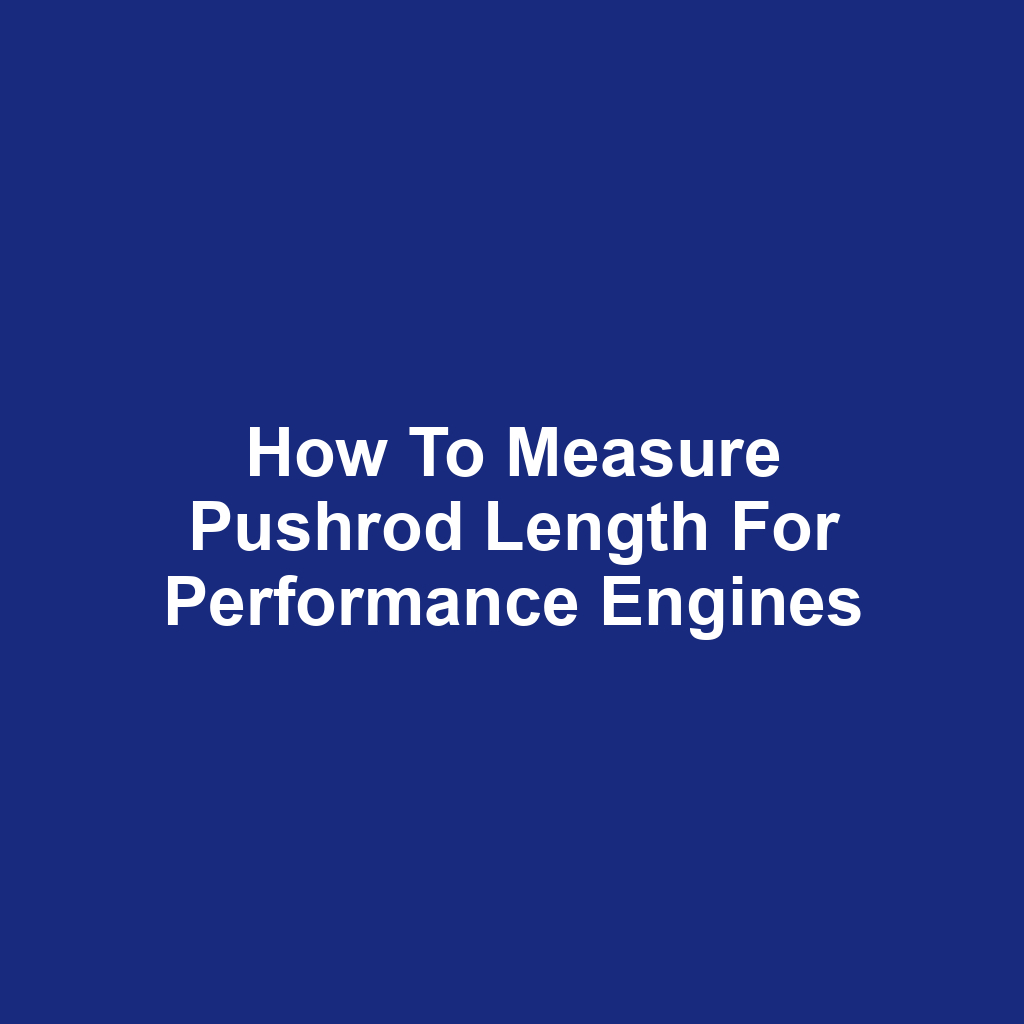When I first dove into building performance engines, I quickly realized that measuring pushrod length was crucial for optimal engine performance. I’ve learned that having the right tools and understanding pushrod geometry can make all the difference. In this article, I’ll share my step-by-step process for accurately measuring pushrod length and highlight some common mistakes I’ve made along the way. I’ll also help you calculate the ideal pushrod length for your specific setup. By the end, you’ll feel confident in finalizing your pushrod selection for that perfect fit.
Choosing the Right Tools for Measurement
I’ve found that using a caliper and a depth gauge makes measuring pushrod length much more accurate. When I first started, I used a standard ruler, but it never gave me the precision I needed. Switching to a digital caliper has really helped; it provides clear and easy-to-read measurements. The depth gauge complements the caliper perfectly, allowing me to measure from different angles. I also prefer tools that have a fine adjustment feature, as it helps me get the exact reading. Keeping my tools calibrated is essential for consistency in my measurements. I’ve learned that even slight errors can lead to performance issues in the engine. Quality tools might cost more upfront, but they save me time and frustration in the long run. Ultimately, investing in the right measuring tools has made a significant difference in my engine builds.
Understanding Pushrod Geometry
Understanding pushrod geometry is crucial for optimizing valve movement in my performance engine setup. I’ve found that the correct pushrod length directly impacts the rocker arm angle and valve lift. If the geometry isn’t right, it can lead to premature wear or even engine failure. I always make sure to check the relationship between the rocker arm and the valve tip. A well-aligned system allows for smoother operation and better performance. I’ve noticed that incorrect geometry can cause binding or excessive stress on components. It’s essential to consider the overall setup, including the camshaft profile and valve train components. I often take into account the adjustments needed for different lifter types as well. Now that I’ve got a solid understanding of pushrod geometry, I’m ready to dive into the step-by-step measurement process.
Step-by-Step Measurement Process
The step-by-step measurement process for pushrod length is crucial for optimizing my engine’s performance. First, I ensure that the engine’s rocker arms are properly adjusted. Then, I rotate the engine to bring the piston to top dead center. After that, I check the lifter’s position to determine its contact point with the rocker arm. I use a pushrod length checker to get an initial measurement. Next, I make small adjustments to the rocker arm’s position. I repeat the measurement process to confirm accuracy. Once I find the correct length, I note it down for future reference. Finally, I install the new pushrods to complete the setup.
Common Mistakes to Avoid
Common mistakes I make include not accounting for changes in lifter preload and using incorrect measuring tools. I often forget to double-check the initial pushrod length before making adjustments. Sometimes, I’ll measure with the engine at the wrong temperature, leading to inaccurate readings. I’ve caught myself neglecting to ensure the rocker arms are properly torqued during measurement. It’s easy to assume that a standard measurement applies to every engine build, but that’s rarely the case. I also tend to skip the step of verifying the alignment of the pushrod in the lifter cup. Occasionally, I rush the process and miss crucial details, like the angle of the pushrod. I’ve learned that not documenting my measurements can lead to confusion later on. Lastly, I forget to consult manufacturer specifications, which can make a significant difference.
Calculating the Ideal Pushrod Length
Calculating the ideal pushrod length involves measuring the distance between the rocker arm and the valve tip while ensuring proper geometry. I always start by assembling the engine with the lifters and rockers in place. Then, I use a checking pushrod to find the right length. After that, I make sure the valve is fully closed during the measurement. It’s crucial that I hold the rocker arm at the correct angle. I double-check my measurements to avoid any errors. Once I have the measurement, I compare it with the recommended pushrod lengths. If it’s off, I adjust accordingly. Finally, I select the pushrod that fits perfectly for optimal performance.
Finalizing Your Pushrod Selection
Finalizing my pushrod selection involves ensuring compatibility with the rest of my engine components. I’ve double-checked the measurements I took earlier, making sure everything lines up perfectly. I’m also considering the material of the pushrods; I want something that can handle the engine’s demands. It’s important for me to review the rocker arm geometry, as it plays a crucial role in performance. I’ve consulted my engine builder for any specific recommendations they might have. I’m looking at the options available and weighing the pros and cons of each type. I’ve also taken into account how my engine’s RPM range might influence my choice. I’ll make sure to keep the overall balance of the engine in mind. Once I finalize my selection, I’ll be ready to install them and see how they perform.
If you’re looking to enhance your performance engine setup, you might also be interested in exploring different technologies that can improve your overall experience. For instance, check out this comprehensive guide on how to install ipk file on lg tv, which provides a step-by-step process that can help you get the most out of your LG TV. It’s a valuable resource for tech enthusiasts looking to optimize their devices!
